The First Survival Score for Patients Treated with Whole-Brain Radiotherapy Plus Simultaneous Integrated Boost for Brain Metastases
Abstract
:Simple Summary
Abstract
1. Introduction
2. Patients and Methods
3. Results
4. Discussion
5. Conclusions
Author Contributions
Funding
Institutional Review Board Statement
Informed Consent Statement
Data Availability Statement
Conflicts of Interest
References
- Gondi, V.; Bauman, G.; Bradfield, L.; Burri, S.H.; Cabrera, A.R.; Cunningham, D.A.; Eaton, B.R.; Hattangadi-Gluth, J.A.; Kim, M.M.; Kotecha, R.; et al. Radiation therapy for brain metastases: An ASTRO clinical practice guideline. Pract. Radiat. Oncol. 2022, 12, 265–282. [Google Scholar] [CrossRef] [PubMed]
- Tsao, M.N.; Rades, D.; Wirth, A.; Lo, S.S.; Danielson, B.L.; Gaspar, L.E.; Sperduto, P.W.; Vogelbaum, M.A.; Radawski, J.D.; Wang, J.Z.; et al. Radiotherapeutic and surgical management for newly diagnosed brain metastasis(es): An American Society for Radiation Oncology evidence-based guideline. Pract. Radiat. Oncol. 2012, 2, 210–225. [Google Scholar] [CrossRef] [PubMed] [Green Version]
- Andrews, D.W.; Scott, C.B.; Sperduto, P.W.; Flanders, A.E.; Gaspar, L.E.; Schell, M.C.; Werner-Wasik, M.; Demas, W.; Ryu, J.; Bahary, J.P.; et al. Whole brain radiation therapy with or without stereotactic radiosurgery boost for patients with one to three brain metastases: Phase III results of the RTOG 9508 randomised trial. Lancet 2004, 363, 1665–1672. [Google Scholar] [CrossRef]
- Rades, D.; Janssen, S.; Dziggel, L.; Blanck, O.; Bajrovic, A.; Veninga, T.; Schild, S.E. A matched-pair study comparing whole-brain irradiation alone to radiosurgery or fractionated stereotactic radiotherapy alone in patients irradiated for up to three brain metastases. BMC Cancer 2017, 17, 30. [Google Scholar] [CrossRef] [Green Version]
- Mantovani, C.; Gastino, A.; Cerrato, M.; Badellino, S.; Ricardi, U.; Levis, M. Modern radiation therapy for the management of brain metastases from non-small cell lung cancer: Current approaches and future directions. Front. Oncol. 2021, 11, 772789. [Google Scholar] [CrossRef]
- Awad, R.; Fogarty, G.; Hong, A.; Kelly, P.; Ng, D.; Santos, D.; Haydu, L. Hippocampal avoidance with volumetric modulated arc therapy in melanoma brain metastases—The first Australian experience. Radiat. Oncol. 2013, 8, 62. [Google Scholar] [CrossRef] [PubMed] [Green Version]
- Dobi, Á.; Fodor, E.; Maráz, A.; Együd, Z.; Cserháti, A.; Tiszlavicz, L.; Reisz, Z.; Barzó, P.; Varga, Z.; Hideghéty, K. Boost irradiation integrated to whole brain radiotherapy in the management of brain metastases. Pathol. Oncol. Res. 2020, 26, 149–157. [Google Scholar] [CrossRef] [Green Version]
- Lagerwaard, F.J.; van der Hoorn, E.A.; Verbakel, W.F.; Haasbeek, C.J.; Slotman, B.J.; Senan, S. Whole-brain radiotherapy with simultaneous integrated boost to multiple brain metastases using volumetric modulated arc therapy. Int. J. Radiat. Oncol. Biol. Phys. 2009, 75, 253–259. [Google Scholar] [CrossRef]
- Hsu, F.; Carolan, H.; Nichol, A.; Cao, F.; Nuraney, N.; Lee, R.; Gete, E.; Wong, F.; Schmuland, M.; Heran, M.; et al. Whole brain radiotherapy with hippocampal avoidance and simultaneous integrated boost for 1-3 brain metastases: A feasibility study using volumetric modulated arc therapy. Int. J. Radiat. Oncol. Biol. Phys. 2010, 76, 1480–1485. [Google Scholar] [CrossRef]
- Tomita, N.; Kodaira, T.; Tachibana, H.; Nakamura, T.; Nakahara, R.; Inokuchi, H.; Shibamoto, Y. Helical tomotherapy for brain metastases: Dosimetric evaluation of treatment plans and early clinical results. Technol. Cancer Res. Treat. 2008, 7, 417–424. [Google Scholar] [CrossRef]
- Rodrigues, G.; Yartsev, S.; Yaremko, B.; Perera, F.; Dar, A.R.; Hammond, A.; Lock, M.; Yu, E.; Ash, R.; Caudrelier, J.M.; et al. Phase I trial of simultaneous in-field boost with helical tomotherapy for patients with one to three brain metastases. Int. J. Radiat. Oncol. Biol. Phys. 2011, 80, 1128–1133. [Google Scholar] [CrossRef] [PubMed]
- Ferro, M.; Chiesa, S.; Macchia, G.; Cilla, S.; Bertini, F.; Frezza, G.; Farioli, A.; Cammelli, S.; Balducci, M.; Ianiro, A.; et al. Intensity modulated radiation therapy with simultaneous integrated boost in patients with brain oligometastases: A phase 1 study (ISIDE-BM-1). Int. J Radiat. Oncol. Biol. Phys. 2017, 97, 82–90. [Google Scholar] [CrossRef] [PubMed]
- Dong, Y.; Zhang, Y.; Zhang, T.; Fan, M.; Zhu, J.; Li, B.; Huang, W. Feasibility and efficacy of simultaneous integrated boost intensity-modulated radiation therapy based on MRI-CT fusion in patients with brain metastases of non-small cell lung cancer. J. Cancer 2018, 9, 4477–4483. [Google Scholar] [CrossRef] [PubMed]
- Westover, K.D.; Mendel, J.T.; Dan, T.; Kumar, K.; Gao, A.; Pulipparacharuv, S.; Iyengar, P.; Nedzi, L.; Hannan, R.; Anderson, J.; et al. Phase II trial of hippocampal-sparing whole brain irradiation with simultaneous integrated boost for metastatic cancer. Neuro Oncol. 2020, 22, 1831–1839. [Google Scholar] [CrossRef] [PubMed]
- Ma, J.; Bi, J.; Tuo, X.; Pi, G.; Li, Y.; Li, Y.; Zeng, F.; Gong, H.; Hu, D.; Han, G. Efficacy and safety of apatinib combined with whole-brain radiation therapy with a simultaneous integrated boost for brain metastases from non-small cell lung cancer: A multicenter retrospective study. J. Thorac. Dis. 2022, 14, 455–463. [Google Scholar] [CrossRef]
- Vargo, J.A.; Plants, B.A.; Mihailidis, D.N.; Mallah, J.; Plants, M.; Welch, C.A.; Clark, G.M.; Farinash, L.J.; Raja, P.; Harmon, M.B.; et al. Early clinical outcomes for 3 radiation techniques for brain metastases: Focal versus whole-brain. Pract. Radiat. Oncol. 2011, 1, 261–270. [Google Scholar] [CrossRef]
- Oehlke, O.; Wucherpfennig, D.; Fels, F.; Frings, L.; Egger, K.; Weyerbrock, A.; Proki, V.; Nieder, C.; Grosu, A.L. Whole brain irradiation with hippocampal sparing and dose escalation on multiple brain metastases: Local tumour control and survival. Strahlenther. Onkol. 2015, 191, 461–469. [Google Scholar] [CrossRef]
- Lebow, E.S.; Hwang, W.L.; Zieminski, S.; Wang, Y.; Niemierko, A.; Mehan, W.A., Jr.; Oh, K.S.; Khandekar, M.; Willers, H.; Shih, H.A. Early experience with hippocampal avoidance whole brain radiation therapy and simultaneous integrated boost for brain metastases. J. Neurooncol. 2020, 148, 81–88. [Google Scholar] [CrossRef]
- Zhong, J.; Waldman, A.D.; Kandula, S.; Eaton, B.R.; Prabhu, R.S.; Huff, S.B.; Shu, H.G. Outcomes of whole-brain radiation with simultaneous in-field boost (SIB) for the treatment of brain metastases. J. Neurooncol. 2020, 147, 117–123. [Google Scholar] [CrossRef]
- Popp, I.; Rau, S.; Hintz, M.; Schneider, J.; Bilger, A.; Fennell, J.T.; Heiland, D.H.; Rothe, T.; Egger, K.; Nieder, C.; et al. Hippocampus-avoidance whole-brain radiation therapy with a simultaneous integrated boost for multiple brain metastases. Cancer 2020, 126, 2694–2703. [Google Scholar] [CrossRef] [Green Version]
- Du, T.Q.; Li, X.; Zhong, W.S.; Tian, J.D.; Zhao, Y.X.; Liu, D. Brain metastases of lung cancer: Comparison of survival outcomes among whole brain radiotherapy, whole brain radiotherapy with consecutive boost, and simultaneous integrated boost. J. Cancer Res. Clin. Oncol. 2021, 147, 569–577. [Google Scholar] [CrossRef] [PubMed]
- Lin, B.; Huang, D.; Du, H.; Fan, J.; Zhang, Y.; Feng, G.; Gao, F.; Du, X.B. Whole-brain radiation therapy with simultaneous integrated boost versus whole-brain radiation therapy plus stereotactic radiosurgery for the treatment of brain metastasis from lung cancer. Front. Oncol. 2021, 11, 631422. [Google Scholar] [CrossRef] [PubMed]
- Grosu, A.L.; Frings, L.; Bentsalo, I.; Oehlke, O.; Brenner, F.; Bilger, A.; Fennell, J.T.; Rothe, T.; Schneider-Fuchs, S.; Graf, E.; et al. Whole-brain irradiation with hippocampal sparing and dose escalation on metastases: Neurocognitive testing and biological imaging (HIPPORAD)—A phase II prospective randomized multicenter trial (NOA-14, ARO 2015-3, DKTK-ROG). BMC Cancer 2020, 20, 532. [Google Scholar] [CrossRef]
- Chia, B.S.H.; Leong, J.Y.; Ong, A.L.K.; Lim, C.; Poon, S.H.; Chua, M.L.K.; Chua, K.L.M.; Kusumawidjaja, G.; Chua, E.T.; Wong, F.Y.; et al. Randomised prospective phase II trial in multiple brain metastases comparing outcomes between hippocampal avoidance whole brain radiotherapy with or without simultaneous integrated boost: HA-SIB-WBRT study protocol. BMC Cancer 2020, 20, 1045. [Google Scholar] [CrossRef]
- Popp, I.; Grosu, A.L.; Fennell, J.T.; Fischer, M.; Baltas, D.; Wiehle, R. Optimization of hippocampus sparing during whole brain radiation therapy with simultaneous integrated boost-tutorial and efficacy of complete directional hippocampal blocking. Strahlenther. Onkol. 2022, 198, 537–546. [Google Scholar] [CrossRef] [PubMed]
- Gaspar, L.; Scott, C.; Rotman, M.; Asbell, S.; Phillips, T.; Wasserman, T.; McKenna, W.G.; Byhardt, R. Recursive partitioning analysis (RPA) of prognostic factors in three Radiation Therapy Oncology Group (RTOG) brain metastases trials. Int. J. Radiat. Oncol. Biol. Phys. 1997, 37, 745–751. [Google Scholar] [CrossRef]
- Weltman, E.; Salvajoli, J.V.; Brandt, R.A.; de Morais Hanriot, R.; Prisco, F.E.; Cruz, J.C.; de Oliveira Borges, S.R.; Wajsbrot, D.B. Radiosurgery for brain metastases: A score index for predicting prognosis. Int. J. Radiat. Oncol. Biol. Phys. 2000, 46, 1155–1161. [Google Scholar] [CrossRef]
- Rades, D.; Dunst, J.; Schild, S.E. A new scoring system to predicting the survival of patients treated with whole-brain radiotherapy for brain metastases. Strahlenther. Onkol. 2008, 184, 251–255. [Google Scholar] [CrossRef]
- Sperduto, P.W.; Berkey, B.; Gaspar, L.E.; Mehta, M.; Curran, W. A new prognostic index and comparison to three other indices for patients with brain metastases: An analysis of 1,960 patients in the RTOG database. Int. J. Radiat. Oncol. Biol. Phys. 2008, 70, 510–514. [Google Scholar] [CrossRef]
- Rades, D.; Dziggel, L.; Nagy, V.; Segedin, B.; Lohynska, R.; Veninga, T.; Khoa, M.T.; Trang, N.T.; Schild, S.E. A new survival score for patients with brain metastases who received whole-brain radiotherapy (WBRT) alone. Radiother. Oncol. 2013, 108, 123–127. [Google Scholar] [CrossRef]
- Lorenzoni, J.; Devriendt, D.; Massager, N.; David, P.; Ruíz, S.; Vanderlinden, B.; Van Houtte, P.; Brotchi, J.; Levivier, M. Radiosurgery for treatment of brain metastases: Estimation of patient eligibility using three stratification systems. Int. J. Radiat. Oncol. Biol. Phys. 2004, 60, 218–224. [Google Scholar] [CrossRef] [PubMed]
- Serizawa, T.; Higuchi, Y.; Nagano, O.; Matsuda, S.; Ono, J.; Saeki, N.; Hirai, T.; Miyakawa, A.; Shibamoto, Y. A new grading system focusing on neurological outcomes for brain metastases treated with stereotactic radiosurgery: The modified Basic Score for Brain Metastases. J. Neurosurg. 2014, 121 (Suppl. S2), 35–43. [Google Scholar] [CrossRef] [PubMed] [Green Version]
- Rades, D.; Pluemer, A.; Veninga, T.; Hanssens, P.; Dunst, J.; Schild, S.E. Whole-brain radiotherapy versus stereotactic radiosurgery for patients in recursive partitioning analysis classes 1 and 2 with 1 to 3 brain metastases. Cancer 2007, 110, 2285–2292. [Google Scholar] [CrossRef] [PubMed]
- Aoyama, H.; Shirato, H.; Tago, M.; Nakagawa, K.; Toyoda, T.; Hatano, K.; Kenjyo, M.; Oya, N.; Hirota, S.; Shioura, H.; et al. Stereotactic radiosurgery plus whole-brain radiation therapy vs stereotactic radiosurgery alone for treatment of brain metastases: A randomized controlled trial. JAMA 2006, 295, 2483–2491. [Google Scholar] [CrossRef] [PubMed]
- Rades, D.; Kueter, J.D.; Hornung, D.; Veninga, T.; Hanssens, P.; Schild, S.E.; Dunst, J. Comparison of stereotactic radiosurgery (SRS) alone and whole brain radiotherapy (WBRT) plus a stereotactic boost (WBRT+SRS) for one to three brain metastases. Strahlenther. Onkol. 2008, 184, 655–662. [Google Scholar] [CrossRef] [PubMed]
- Kocher, M.; Soffietti, R.; Abacioglu, U.; Villà, S.; Fauchon, F.; Baumert, B.G.; Fariselli, L.; Tzuk-Shina, T.; Kortmann, R.D.; Carrie, C.; et al. Adjuvant whole-brain radiotherapy versus observation after radiosurgery or surgical resection of one to three cerebral metastases: Results of the EORTC 22952-26001 study. J. Clin. Oncol. 2011, 29, 134–141. [Google Scholar] [CrossRef] [Green Version]
- Rades, D.; Hornung, D.; Veninga, T.; Schild, S.; Gliemroth, J. Single brain metastasis: Radiosurgery alone compared with radiosurgery plus up-front whole-brain radiotherapy. Cancer 2012, 118, 2980–2985. [Google Scholar] [CrossRef] [Green Version]
- Chang, E.L.; Wefel, J.S.; Hess, K.R.; Allen, P.K.; Lang, F.F.; Kornguth, D.G.; Arbuckle, R.B.; Swint, J.M.; Shiu, A.S.; Maor, M.H.; et al. Neurocognition in patients with brain metastases treated with radiosurgery or radiosurgery plus whole-brain irradiation: A randomised controlled trial. Lancet Oncol. 2009, 10, 1037–1044. [Google Scholar] [CrossRef]
- Brown, P.D.; Jaeckle, K.; Ballman, K.V.; Farace, E.; Cerhan, J.H.; Anderson, S.K.; Carrero, X.W.; Barker, F.G., 2nd; Deming, R.; Burri, S.H.; et al. Effect of Radiosurgery alone vs radiosurgery with whole brain radiation therapy on cognitive function in patients with 1 to 3 brain metastases: A randomized clinical trial. JAMA 2016, 316, 401–409. [Google Scholar] [CrossRef]
- Huttenlocher, S.; Dziggel, L.; Horning, D.; Blanck, O.; Schild, S.E.; Rades, D. A new prognostic instrument to predict the probability of developing new cerebral metastases after radiosurgery alone. Radiat. Oncol. 2014, 9, 267. [Google Scholar] [CrossRef] [Green Version]
- Minniti, G.; Scaringi, C.; Paolini, S.; Lanzetta, G.; Romano, A.; Cicone, F.; Osti, M.; Enrici, R.M.; Esposito, V. Single-fraction versus multifraction (3 × 9 Gy) stereotactic radiosurgery for large (>2 cm) brain metastases: A comparative analysis of local control and risk of radiation-induced brain necrosis. Int. J. Radiat. Oncol. Biol. Phys. 2016, 95, 1142–1148. [Google Scholar] [CrossRef] [PubMed]

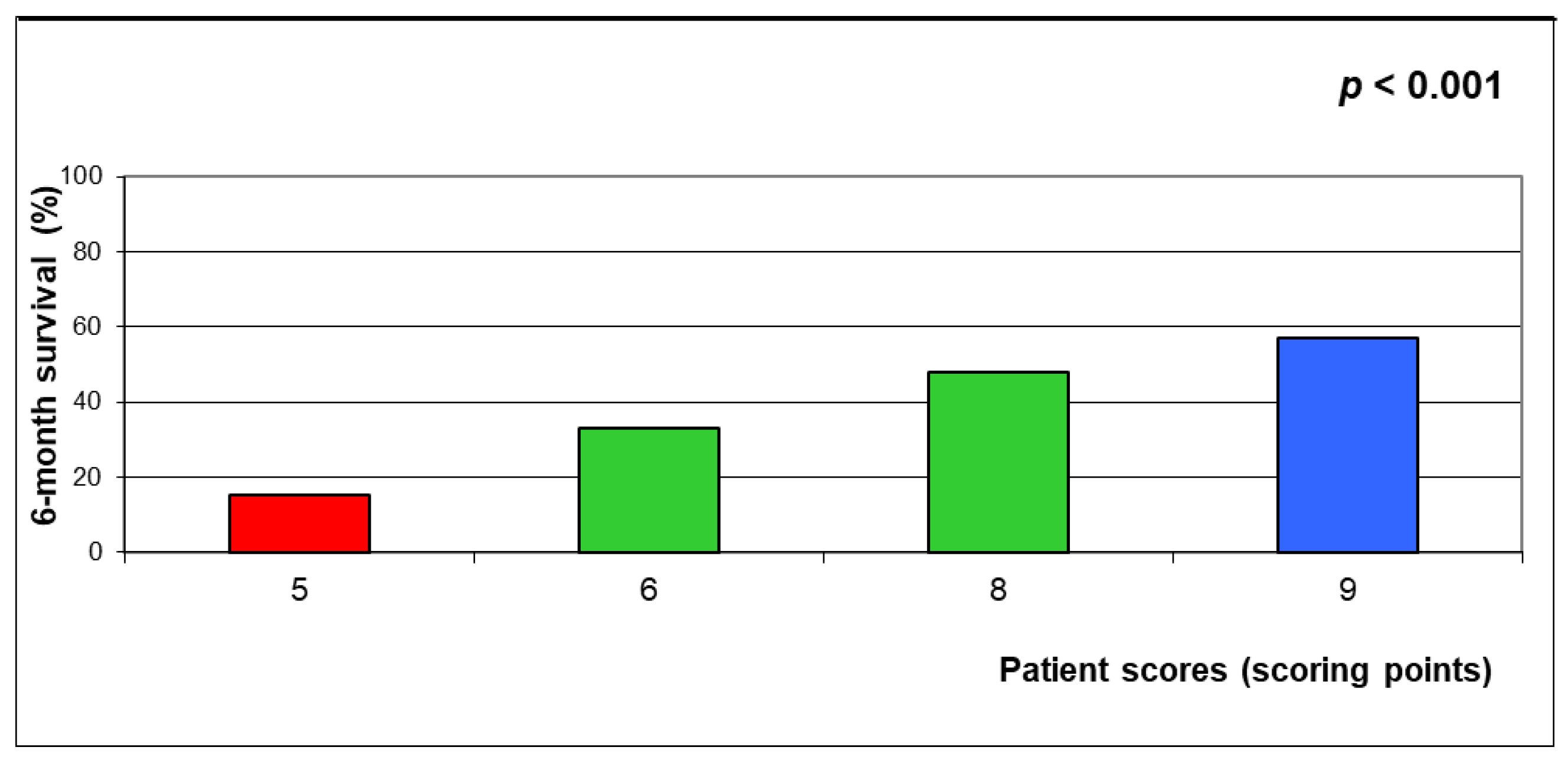
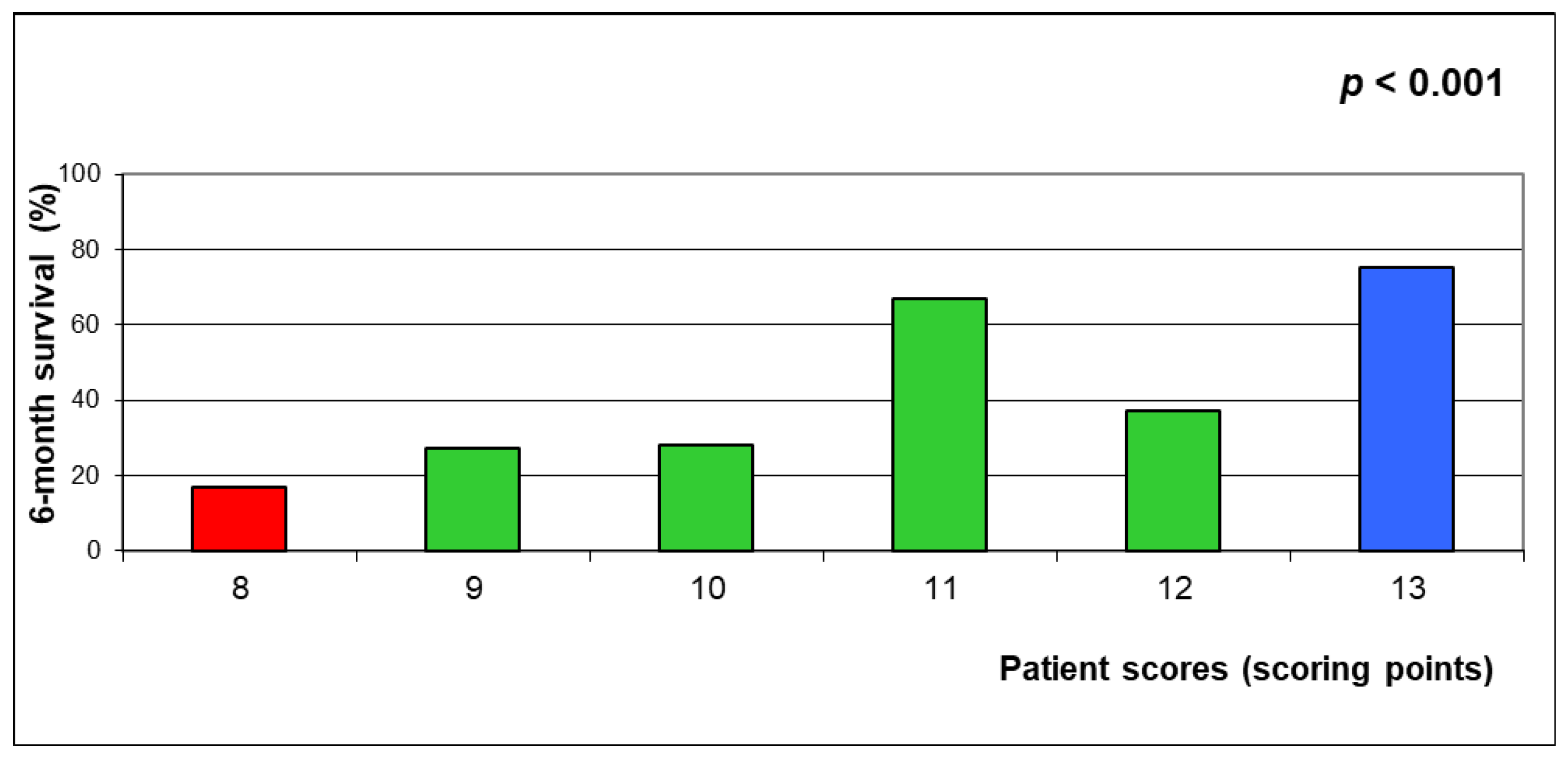
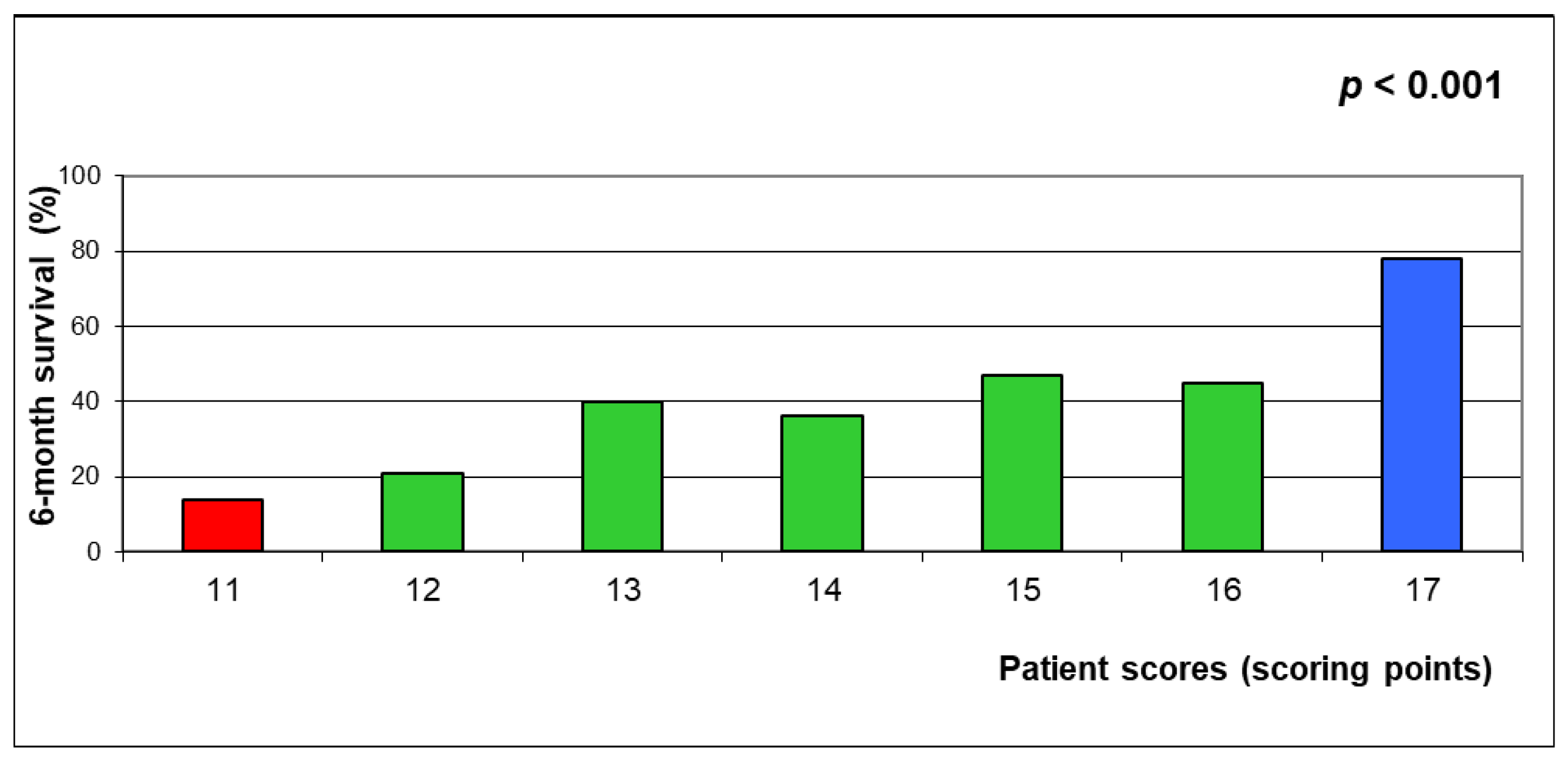
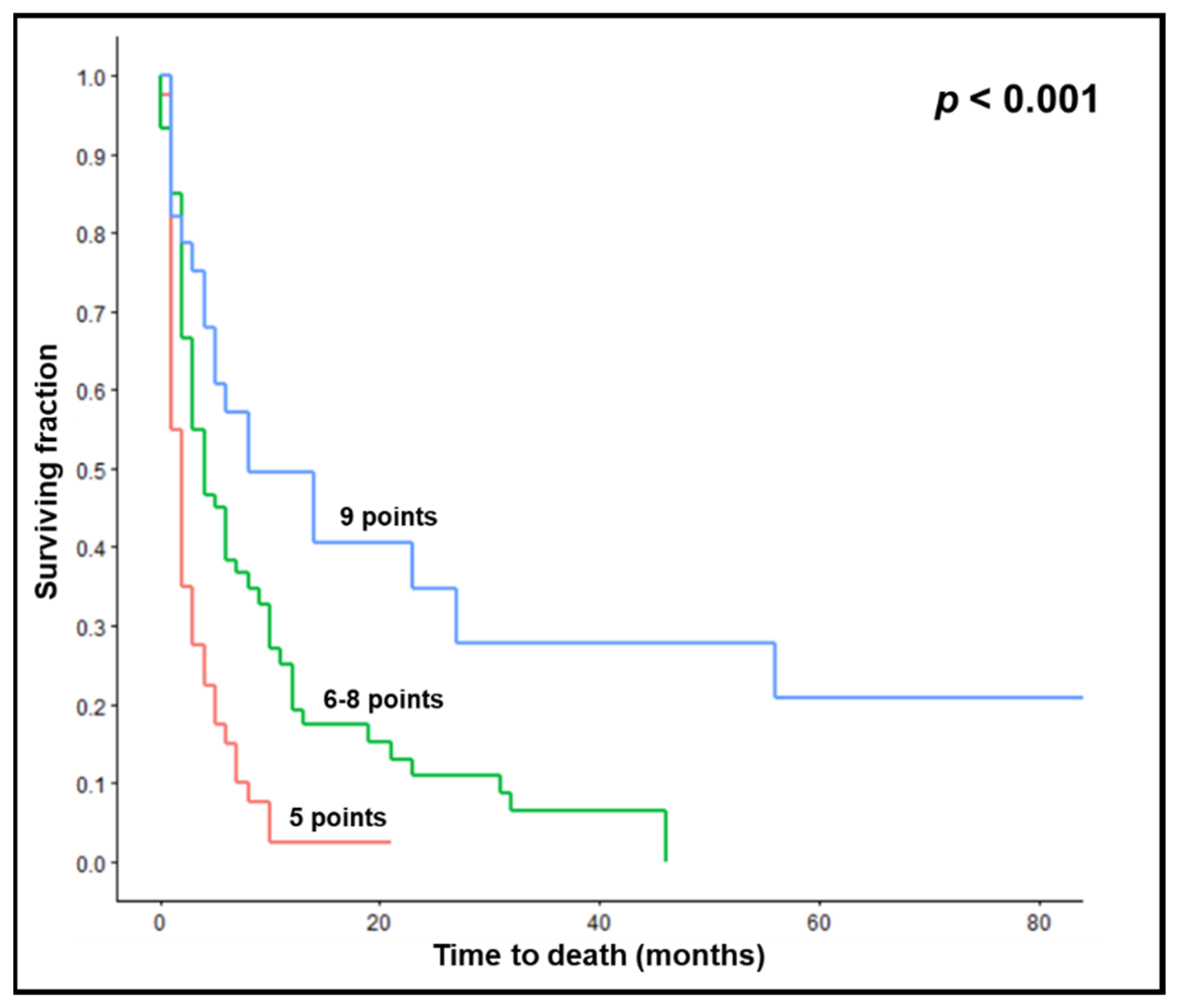
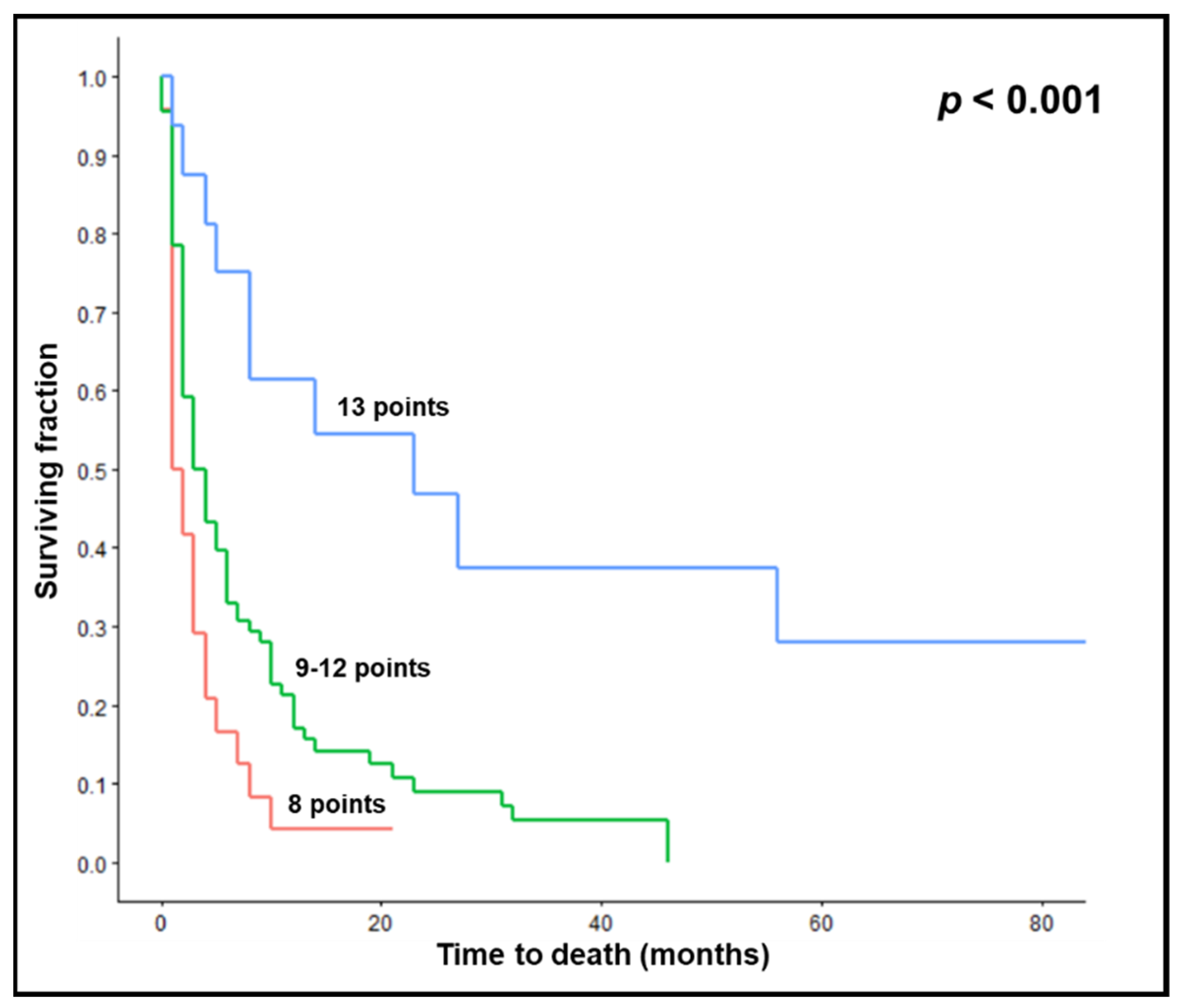

| Factor | Number of Patients | Proportion (%) |
|---|---|---|
| Year of treatment | ||
| 2014–2018 | 72 | 56 |
| 2019–2021 | 56 | 44 |
| Time between tumor diagnosis and RT | ||
| 0–1 months | 70 | 55 |
| ≥2 months | 58 | 45 |
| RT regimen | ||
| 14 × 2.5 Gy of WBRT + SIB | 49 | 38 |
| 18 × 2.0 Gy of WBRT + SIB | 79 | 62 |
| Pre-RT systemic treatment | ||
| No | 79 | 62 |
| Yes | 49 | 38 |
| Age at RT | ||
| ≤64 years | 65 | 51 |
| ≥65 years | 63 | 49 |
| Gender | ||
| Female | 49 | 38 |
| Male | 79 | 62 |
| Karnofsky performance score | ||
| ≤80 | 79 | 62 |
| 90–100 | 49 | 38 |
| Type of primary tumor | ||
| Breast cancer | 8 | 6 |
| Non-small cell lung cancer | 77 | 60 |
| Small-cell lung cancer | 18 | 14 |
| Less radiosensitive tumors | 13 | 10 |
| Other types | 12 | 9 |
| Number of brain lesions | ||
| 1–3 | 67 | 52 |
| ≥4 | 61 | 48 |
| Extra-cerebral metastases | ||
| No | 47 | 37 |
| Yes | 81 | 63 |
| Factor | Survival Rate (%) | p-Value | ||
|---|---|---|---|---|
| at 3 Months | at 6 Months | at 12 Months | ||
| Year of treatment | 0.34 | |||
| 2014–2018 | 51 | 36 | 23 | |
| 2019–2021 | 50 | 34 | 17 | |
| Time between tumor diagnosis and RT | 0.56 | |||
| 0–1 months | 56 | 40 | 23 | |
| ≥2 months | 45 | 29 | 18 | |
| RT regimen | 0.55 | |||
| 14 x 2.5 Gy of WBRT + SIB | 55 | 37 | 22 | |
| 18 x 2.0 Gy of WBRT + SIB | 48 | 34 | 19 | |
| Pre-RT systemic treatment | 0.84 | |||
| No | 52 | 35 | 23 | |
| Yes | 49 | 35 | 15 | |
| Age at RT | 0.061 | |||
| ≤64 years | 55 | 38 | 25 | |
| ≥65 years | 46 | 32 | 16 | |
| Gender | 0.30 | |||
| Female | 43 | 33 | 30 | |
| Male | 56 | 37 | 15 | |
| Karnofsky performance score | <0.001 | |||
| ≤80 | 37 | 24 | 10 | |
| 90–100 | 73 | 53 | 37 | |
| Type of primary tumor | 0.26 | |||
| Breast cancer | 50 | 38 | 25 | |
| Non-small cell lung cancer | 53 | 38 | 24 | |
| Small-cell lung cancer | 50 | 28 | 0 | |
| Less radiosensitive tumors | 62 | 46 | 23 | |
| Other types | 25 | 17 | 17 | |
| Number of brain lesions | 0.006 | |||
| 1–3 | 58 | 43 | 31 | |
| ≥4 | 43 | 26 | 9 | |
| Extra-cerebral metastases | 0.128 | |||
| No | 55 | 40 | 31 | |
| Yes | 48 | 32 | 14 | |
| Factor | Survival Rate at 6 Months (%) | Scoring Points |
|---|---|---|
| Karnofsky performance score | ||
| 90–100 | 53 | 5 |
| ≤80 | 24 | 2 |
| Number of brain lesions | ||
| 1–3 | 43 | 4 |
| ≥4 | 26 | 3 |
| Age at radiotherapy | ||
| ≤64 years | 38 | 4 |
| ≥65 years | 32 | 3 |
| Extra-cerebral metastases | ||
| No | 40 | 4 |
| Yes | 32 | 3 |
Disclaimer/Publisher’s Note: The statements, opinions and data contained in all publications are solely those of the individual author(s) and contributor(s) and not of MDPI and/or the editor(s). MDPI and/or the editor(s) disclaim responsibility for any injury to people or property resulting from any ideas, methods, instructions or products referred to in the content. |
© 2023 by the authors. Licensee MDPI, Basel, Switzerland. This article is an open access article distributed under the terms and conditions of the Creative Commons Attribution (CC BY) license (https://creativecommons.org/licenses/by/4.0/).
Share and Cite
Rades, D.; Johannwerner, L.; Werner, E.M.; Cremers, F.; Yu, N.Y. The First Survival Score for Patients Treated with Whole-Brain Radiotherapy Plus Simultaneous Integrated Boost for Brain Metastases. Biology 2023, 12, 585. https://doi.org/10.3390/biology12040585
Rades D, Johannwerner L, Werner EM, Cremers F, Yu NY. The First Survival Score for Patients Treated with Whole-Brain Radiotherapy Plus Simultaneous Integrated Boost for Brain Metastases. Biology. 2023; 12(4):585. https://doi.org/10.3390/biology12040585
Chicago/Turabian StyleRades, Dirk, Leonie Johannwerner, Elisa M. Werner, Florian Cremers, and Nathan Y. Yu. 2023. "The First Survival Score for Patients Treated with Whole-Brain Radiotherapy Plus Simultaneous Integrated Boost for Brain Metastases" Biology 12, no. 4: 585. https://doi.org/10.3390/biology12040585





